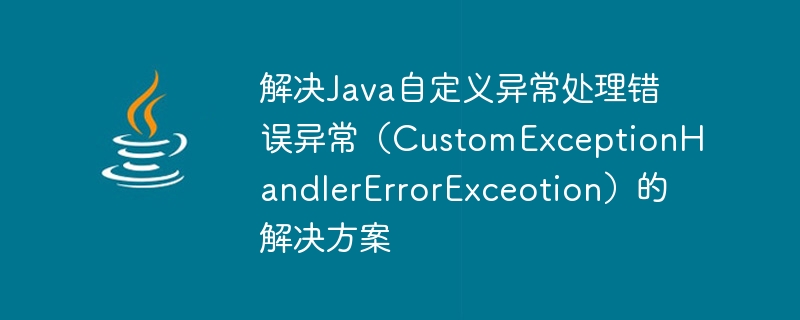Home >Java >javaTutorial >Solution to solve Java custom exception handling error exception (CustomExceptionHandlerErrorExceotion)
Solution to solve Java custom exception handling error exception (CustomExceptionHandlerErrorExceotion)
- WBOYWBOYWBOYWBOYWBOYWBOYWBOYWBOYWBOYWBOYWBOYWBOYWBOriginal
- 2023-08-27 10:21:39980browse

Solution to solve Java custom exception handling error exception (CustomExceptionHandlerErrorExceotion)
In Java development, exception handling is an important topic. When errors occur in the code, Java provides a set of exception mechanisms to help us catch and handle these errors. In addition to Java's built-in exception types, we can also customize exceptions to better meet the needs of the project. However, sometimes we may encounter a situation where custom exceptions cannot be handled correctly. This article describes a solution to this problem and provides corresponding code examples.
First, we need to customize an exception class CustomExceptionHandlerErrorExceotion, as shown below:
public class CustomExceptionHandlerErrorExceotion extends RuntimeException {
public CustomExceptionHandlerErrorExceotion(String message) {
super(message);
}
}In the code, we inherit the custom exception class from RuntimeException, which is an unchecked exception . Next, we need to throw this custom exception in our code. For example, we determine whether a certain condition is met in a method, and if it is not met, a CustomExceptionHandlerErrorExceotion will be thrown:
public void someMethod() {
// 判断某个条件是否满足
if (!condition) {
throw new CustomExceptionHandlerErrorExceotion("条件不满足");
}
}At this time, if the condition in the method someMethod is not met, a CustomExceptionHandlerErrorExceotion will be thrown, and it can Capture and process elsewhere in the call stack.
However, sometimes we may find that although we throw CustomExceptionHandlerErrorExceotion correctly in the code, it is not caught and handled correctly. This may be because we did not take into account the custom exception when catching the exception. To solve this problem, we can add a general exception handler to the code to catch and handle all types of exceptions, including custom exceptions.
The following is a sample code that adds a general exception handler:
@ControllerAdvice
public class GlobalExceptionHandler {
@ExceptionHandler(value = {CustomExceptionHandlerErrorExceotion.class})
public ResponseEntity<Object> handleCustomExceptionHandlerErrorExceotion(CustomExceptionHandlerErrorExceotion ex) {
// 自定义异常的处理逻辑
// 返回适当的响应给客户端
}
@ExceptionHandler(value = {Exception.class})
public ResponseEntity<Object> handleException(Exception ex) {
// 其他异常的处理逻辑
// 返回适当的响应给客户端
}
}In the above code, we use the @ControllerAdvice annotation to annotate a class, which is used for global exception handling. Then, we use the @ExceptionHandler annotation to specify methods for handling CustomExceptionHandlerErrorExceotion exceptions, as well as methods for handling other exceptions. In these methods, we can write corresponding processing logic according to actual needs and return appropriate responses to the client.
Through the above solution, we can ensure that the custom exception CustomExceptionHandlerErrorExceotion is handled correctly in the code. When this exception is thrown, the exception handler will be automatically triggered and processed according to the specified processing logic.
To sum up, the solution to Java custom exception handling errors is to add a general exception handler and write corresponding processing logic in the handler based on the actual exception type. This way we can ensure that custom exceptions are caught and handled correctly.
I hope the solutions in this article can inspire you to deal with custom exceptions in Java development. Through in-depth study and practice of exception handling, we can write more robust and reliable code.
The above is the detailed content of Solution to solve Java custom exception handling error exception (CustomExceptionHandlerErrorExceotion). For more information, please follow other related articles on the PHP Chinese website!

